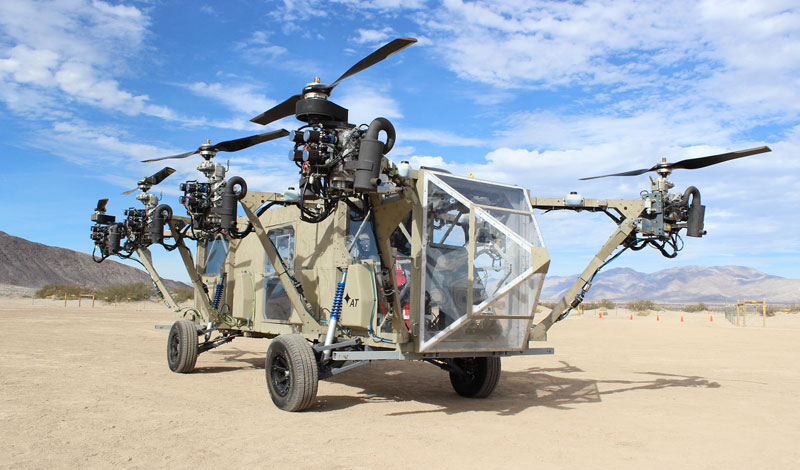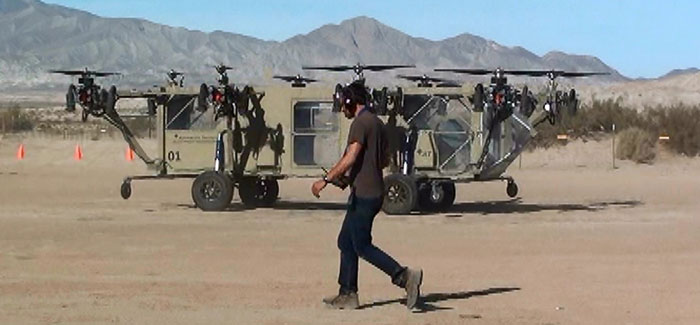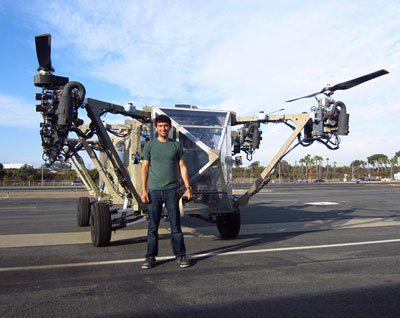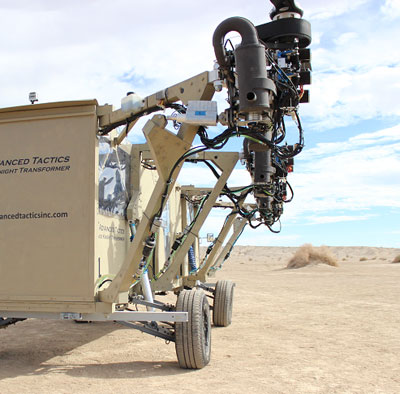
A hybrid vehicle combining an off-road automobile and multirotor helicopter is set to become the world’s first roadable, vertical takeoff and landing (VTOL) aircraft.

A small California based aerospace company named Advanced Tactics Inc. (AT) released first details about the AT Transformer vehicle technology this week. AT is set to test its AT Black Knight Transformer technology demonstrator within the next month, following the completion of driving tests last month. The tests are performed n Southern California. Following the first flight which will be unmanned (remotely piloted) and tethered, the Black Knight Transformer will enter more expansive, iterative flight testing program leading to a full-capability demonstration in late 2014.
AT’s ‘Black Knight’ Transformer is based on an innovative technology pioneered by AT, that combines the capabilities of a rotorcraft, and an off-road vehicle. “This design is simple and robust, by eliminating the mechanical complexity and cost of the articulated rotor system that stabilizes and controls a conventional helicopter and replacing it with a high-speed computerized feedback control system.” Rustom Jehangir AT’s Chief Engineer told Defense-Update, “Additionally, the configuration negates the need for a tail-rotor or engine transmission.” while the multirotor concept has been familiar for almost 90 years (the first helicopters, designed in the 1920 were in fact quadrotors), their application was extremely complex and unreliable using mechanical synchronization and control. “Today we can run the rotors through direct drives, while leaving the stabilization, elevation and attitude control to the computerized system that controls the engines.” Jehangir said, adding that AT developed an application that controls the rotation speed of gas or diesel engines in the resolution that enables dynamic stabilization of the octocopter.


The Black Knight Transformer is designed for autonomous casualty evacuation and manned or unmanned cargo resupply missions. The interior volume is comparable to a Blackhawk helicopter, thus making it suitable for cargo resupply and support missions. An unmanned transformer could be used for combat casualty evacuation (CASEVAC) while a similar optionally manned configuration could be optimized for Special Operations missions. On an typical CASEVAC mission evacuating a wounded soldier under fire from a hot battle zone, a Black Knight Transformer would dispatch to the site landing zone designated by the wounded soldier’s squad. The flexibility of the vehicle’s transportation capability means they can drive the vehicle to areas which otherwise cannot support safe rotorcraft operation.
Development began in 2010, under congressionally funded ‘Special Interest Program’ to develop an unmanned platform for combat casualty evacuation. For the first two years the program was supported by the US Army Telemedicine and Advanced Technology Research Center (TATRC) but in 2012 the Marine Corps and Air Force Research laboratory (AFRL) have joined and expanded its scope. Despite the early start AT was not selected for the DARPA Transformer program, where transformer type vehicles are developed for similar applications. Now, with the relative maturity of the program, AT is scouting the industry to collaborate and seize joint development opportunities taking its innovative technologies into full production.

In fact, the operational configuration of the Black Knight Transformer would meet (and possibly exceed) the DARPA Transformer requirements. It will be configured with 19 foot long cargo hold (19x4x4), carrying five passengers or payload capacity of over 1,000 lbs (454 kg). Loading will be supported by a loading ramp for quick roll-on roll-off loading and offloading. The Black Knight Transformer will be able to deploy in flight over a 250 nm range (463 km) and dash for 30 km over road or rough terrain at a speed of 70 mph (112 km/h). In the aircraft mode it will cruise at a speed of 130 kts (240 km/h). Designed from the start for special ops, the entire vehicle will be transportable inside the CV-22 cargo hold. An inherent difference from the DARPA Transformers will be the use of turbo diesel engines and open rotors, instead of electrical motors and ducted fan or counter-rotating rotors developed under the DARPA program.
AT began work on the Black Knight Transformer in 2010 and, beginning with electrically powered models. Two years later, AT tested the first sub-scale gas-powered ‘Panther Transformer’ and by the end of 2013 the full-scale vehicle completed the first test runs on land.

The Black Knight and Panther Transformers both utilize the AT Transformer technology, which leverages the simplicity and robustness of a “multirotor” helicopter at a full-scale size. Like the small electric multicopters that are prevalent today, the AT Transformer uses engines with a direct drive connection to prop-rotors. The vehicle is stabilized in flight by balancing the thrust generated by opposing rotors – four pairs are employed for the Black Knight application. The vehicle is designed with commercial off the shelf elements, including the motors and rotor systems.
By using direct drive, the drive chain is simplified and more reliable. Overall, the structure and automotive systems are configured into modular, field replaceable components. To support off-road mobility the vehicle has automotive suspensions and drive-trains similar to those used in off-road trucks. Large truck tires and shocks provide excellent terrain handling and soften the vehicles’ landings. The wheels are driven by an independent engine and transaxle for speeds up to 70 mph (112 km/h).
For instance, each of the eight propulsion subsystems can be replaced in the field by two people and the payload bay can be changed from casualty evacuation life support equipment to cargo for multi-mission capabilities. Additionally, the modular automobile portion of the vehicle can be replaced with a boat hull or an amphibious hull for water operations. The AT Transformer has the ability to perform controlled engine-out flight in case of a critical component failure.




















